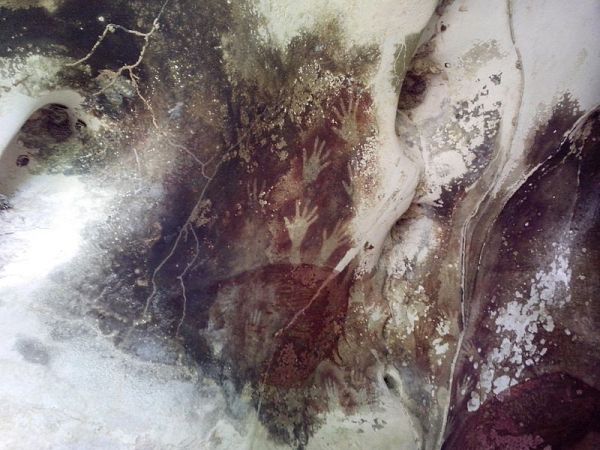Leang
Jarie, or “Cave of Fingers,” in the island of Sulawesi in Indonesia has
long been known for the stenciled handprints on the walls. But it was
only announced in 2014 that the actual age of the paintings there and in
other caves on Sulawesi were determined to be at least 35,400 years.
That would make them among the oldest art in the world, and opens up
many questions about the evolution and dispersal of humans around the
world. The method used to date the paintings is fascinating.
Archaeologist and geochemist Maxime Aubert knew that analyzing radioactive decay would give a date to inorganic material that carbon dating can’t.
Instead
of analyzing pigment from the paintings directly, he wanted to date the
rock they sat on, by measuring radioactive uranium, which is present in
many rocks in trace amounts. Uranium decays into thorium at a known
rate, so comparing the ratio of these two elements in a sample reveals
its age; the greater the proportion of thorium, the older the sample.
The technique, known as uranium series dating, was used to determine
that zircon crystals from Western Australia were more than four billion
years old, proving Earth’s minimum age. But it can also date newer
limestone formations, including stalactites and stalagmites, known
collectively as speleothems, which form in caves as water seeps or flows
through soluble bedrock.
Aubert got a chance to analyze
the cave paintings on Sulawesi, which were partially covered by
speleothems (called popcorn). As they formed on top of the images, they
have to be younger than the paintings themselves.
Aubert
spent a week the next summer touring the region by motorbike. He took
samples from five paintings partly covered by popcorn, each time using a
diamond-tipped drill to cut a small square out of the rock, about 1.5
centimeters across and a few millimeters deep.
Back in Australia,
he spent weeks painstakingly grinding the rock samples into thin layers
before separating out the uranium and thorium in each one. “You collect
the powder, then remove another layer, then collect the powder,” Aubert
says. “You’re trying to get as close as possible to the paint layer.”
Then he drove from Wollongong to Canberra to analyze his samples using
the mass spectrometer, sleeping in his van outside the lab so he could
work as many hours as possible, to minimize the number of days he needed
on the expensive machine. Unable to get funding for the project, he had
to pay for his flight to Sulawesi—and for the analysis—himself. “I was
totally broke,“ he says.
The very first age Aubert calculated was
for a hand stencil from the Cave of Fingers. “I thought, ‘Oh, shit,’”
he says. “So I calculated it again.” Then he called Brumm.
“I
couldn’t make sense of what he was saying,” Brumm recalls. “He blurted
out, ‘35,000!’ I was stunned. I said, are you sure? I had the feeling
immediately that this was going to be big.”
The dating method is just one small part of
an article at Smithsonian magazine about the Indonesian cave paintings. Take a tour to the caves themselves, and learn why their age is so important to our understanding of human history.


No comments:
Post a Comment